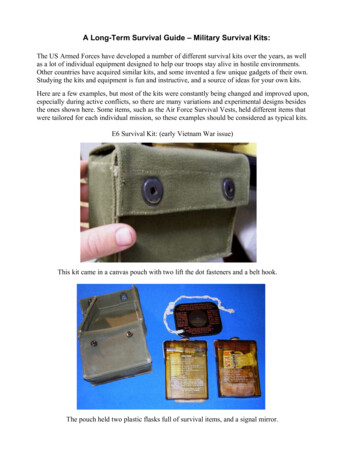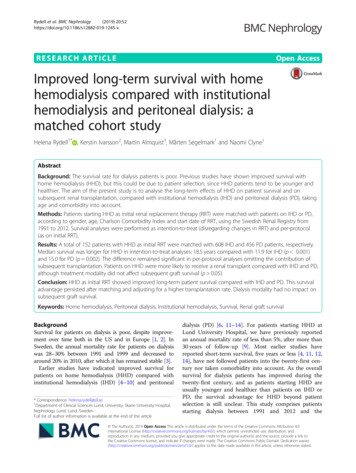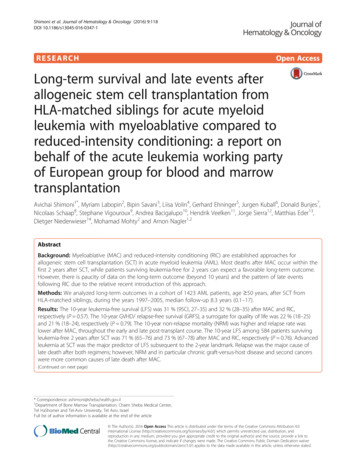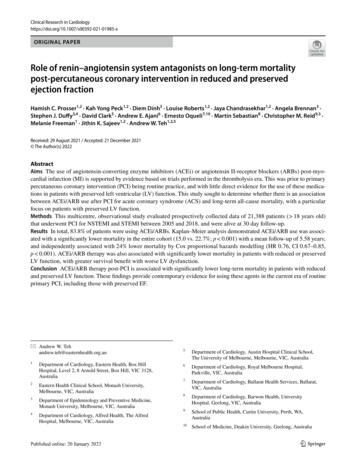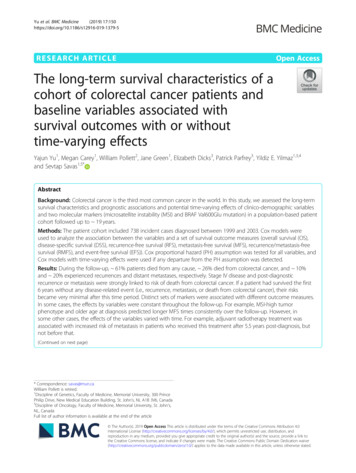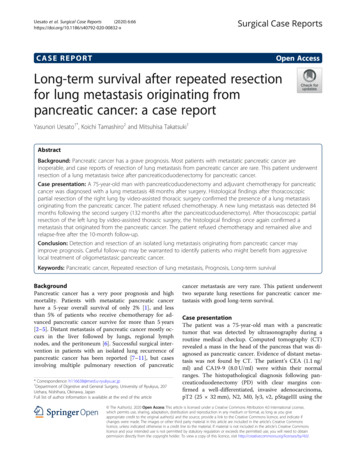
Transcription
Uesato et al. Surgical Case Reports(2020) 6:66https://doi.org/10.1186/s40792-020-00832-xCASE REPORTOpen AccessLong-term survival after repeated resectionfor lung metastasis originating frompancreatic cancer: a case reportYasunori Uesato1*, Koichi Tamashiro2 and Mitsuhisa Takatsuki1AbstractBackground: Pancreatic cancer has a grave prognosis. Most patients with metastatic pancreatic cancer areinoperable, and case reports of resection of lung metastasis from pancreatic cancer are rare. This patient underwentresection of a lung metastasis twice after pancreaticoduodenectomy for pancreatic cancer.Case presentation: A 75-year-old man with pancreaticoduodenectomy and adjuvant chemotherapy for pancreaticcancer was diagnosed with a lung metastasis 48 months after surgery. Histological findings after thoracoscopicpartial resection of the right lung by video-assisted thoracic surgery confirmed the presence of a lung metastasisoriginating from the pancreatic cancer. The patient refused chemotherapy. A new lung metastasis was detected 84months following the second surgery (132 months after the pancreaticoduodenectomy). After thoracoscopic partialresection of the left lung by video-assisted thoracic surgery, the histological findings once again confirmed ametastasis that originated from the pancreatic cancer. The patient refused chemotherapy and remained alive andrelapse-free after the 10-month follow-up.Conclusion: Detection and resection of an isolated lung metastasis originating from pancreatic cancer mayimprove prognosis. Careful follow-up may be warranted to identify patients who might benefit from aggressivelocal treatment of oligometastasic pancreatic cancer.Keywords: Pancreatic cancer, Repeated resection of lung metastasis, Prognosis, Long-term survivalBackgroundPancreatic cancer has a very poor prognosis and highmortality. Patients with metastatic pancreatic cancerhave a 5-year overall survival of only 2% [1], and lessthan 5% of patients who receive chemotherapy for advanced pancreatic cancer survive for more than 5 years[2–5]. Distant metastasis of pancreatic cancer mostly occurs in the liver followed by lungs, regional lymphnodes, and the peritoneum [6]. Successful surgical intervention in patients with an isolated lung recurrence ofpancreatic cancer has been reported [7–11], but casesinvolving multiple pulmonary resection of pancreatic* Correspondence: h116638@med.u-ryukyu.ac.jp1Department of Digestive and General Surgery, University of Ryukyus, 207Uehara, Nishihara, Okinawa, JapanFull list of author information is available at the end of the articlecancer metastasis are very rare. This patient underwenttwo separate lung resections for pancreatic cancer metastasis with good long-term survival.Case presentationThe patient was a 75-year-old man with a pancreatictumor that was detected by ultrasonography during aroutine medical checkup. Computed tomography (CT)revealed a mass in the head of the pancreas that was diagnosed as pancreatic cancer. Evidence of distant metastasis was not found by CT. The patient’s CEA (1.1 ng/ml) and CA19-9 (8.0 U/ml) were within their normalranges. The histopathological diagnosis following pancreaticoduodenectomy (PD) with clear margins confirmed a well-differentiated, invasive adenocarcinoma,pT2 (25 32 mm), N2, M0, ly3, v2, pStageIII using the The Author(s). 2020 Open Access This article is licensed under a Creative Commons Attribution 4.0 International License,which permits use, sharing, adaptation, distribution and reproduction in any medium or format, as long as you giveappropriate credit to the original author(s) and the source, provide a link to the Creative Commons licence, and indicate ifchanges were made. The images or other third party material in this article are included in the article's Creative Commonslicence, unless indicated otherwise in a credit line to the material. If material is not included in the article's Creative Commonslicence and your intended use is not permitted by statutory regulation or exceeds the permitted use, you will need to obtainpermission directly from the copyright holder. To view a copy of this licence, visit http://creativecommons.org/licenses/by/4.0/.
Uesato et al. Surgical Case Reports(2020) 6:66eighth edition UICC classification system criteria. Adjuvant chemotherapy with tegafur, gimeracil, and oteracilpotassium (100 mg/day) was given for 1 year post-PD. Atthe 48-month follow-up, a new 5 3-mm lesion in thelower right lobe of the lung was detected by CT (Fig. 1).It was a new lesion suggestive of malignant disease, andmetastatic lung cancer was suspected because it was anisolated solid mass. The patient’s CEA (1.2 ng/ml) andCA19-9 (5.0 U/ml) concentrations were normal, andother metastases were not detected by CT. Histopathological findings of the lung lesion following thoracoscopic partial resection of the right lung by videoassisted thoracic surgery (VATS) revealed a welldifferentiated tumor with irregular growth of atypicalgland ducts showing irregular flexion and bifurcationcharacteristic of a mucus-producing adenocarcinoma.Immunostaining findings were consistent with a lungmetastasis of pancreatic cancer rather than a primarylung cancer (Fig. 2). Adjuvant chemotherapy was recommended to prevent recurrence because the lung metastasis was suspected to be pancreatic cancer based on theclinical course, but the patient refused.Eighty-four months after the first pulmonary resection(132 months after PD), CT and positron emission tomography (PET) revealed a new 10 10-mm lesion in thelower lobe of the left lung (Fig. 3). A lung metastasis wassuspected because the mass was new, isolated, solid, andhad smooth margin. However, pleural invagination wasalso found, suggesting primary lung cancer. A bronchoscopy for a histopathological diagnosis was not performedbecause of the tumor location. CT and PET did not findFig. 1 Computed tomography (CT) shows a 5 3-mm tumor mass nearthe base of the right lung. This was a new isolated, localized, solid lesionPage 2 of 6other metastases. Serum CA19-9 was high (90 U/ml,normal 37 U/ml). VATS was performed and wasfollowed by an uneventful postoperative recovery without severe complications and a return of the CA19-9concentration to normal levels. The histopathologicalfindings were similar to those for the first lung lesion,finding a well-differentiated adenocarcinoma that wasdiagnosed as a pancreatic cancer metastasis (Fig. 4). Thepatient refused adjuvant chemotherapy and had experienced no severe complications or relapse at the 10month follow-up.DiscussionGenerally, patients with recurrent pancreatic cancer areindicated for chemotherapy or best supportive care, andnot for surgical intervention. The prognosis is extremelypoor for recurrence in the liver even if the lesion is solitary[12], but surgical intervention for solitary recurrence in thelung has been reported to improve prognosis [7–11].Downs-Canner et al. reported that surgery for lung recurrences prolonged overall survival compared with chemotherapy or best supportive care [13]. Our patient remainedalive and recurrence-free 142 months after PD, which is farlonger than expected for stage III pancreatic cancer.Previous reports of surgical intervention for pancreaticcancer recurrence in the lung are summarized in Table 1.The mean time to pulmonary resection was 26 months.Most patients had one lung recurrence, and the meanoverall survival after lung resection was 34 months. As inthis patient, the time to subsequent recurrence was prolonged, and overall survival was improved, by pulmonaryresection. Only one previous report included multiple resection procedures, and in line with our experience, thepatient also had long-term survival of 8 years after surgery.The available evidence indicated that pulmonary resectionfor recurrence can significantly prolong survival in selected patients.Distinguishing between primary and metastatic lungcancer is needed to guide treatment. Thyroid transcription factor (TTF)-1 expression has been described as auseful marker of primary lung cancer and highly specificfor primary lung adenocarcinoma [14, 15]. TTF-1 immunostaining was negative in this patient. However, because TTF-1 positivity is reported to be low inmucinous bronchioloalveolar carcinoma, it was not conclusive in this case of mucin-producing adenocarcinoma[16]. Cytokeratin (CK)7 and CK20 are useful for distinguishing between lung primary and metastatic tumors.Primary lung cancer has many CK-positive and CKnegative patterns, which are not consistent with thefindings of this case, but there are reports of CK7- andCK20-positive mucinous bronchioloalveolar carcinomas[17, 18]. Napsin A has been reported to be specific forprimary lung adenocarcinoma and was negative in this
Uesato et al. Surgical Case Reports(2020) 6:66Page 3 of 6Fig. 2 Histopathological and immunostaining findings with a the tumor location indicated by the circle and b hematoxylin-eosin staining of tissue withcolumnar tumor cells, nuclear atypia, and mucus containing mucus vesicles. Immunostaining shows c, d diffuse expression of cytokeratin 7 and 20 and e, fnegative staining of thyroid transcription factor 1 and Napsin Acase [19]. Although it was difficult to completely ruleout primary lung cancer in this patient by histopathologyand immunostaining, the findings were consistent withmetastatic lung cancer and were also consistent with theclinical course.The available evidence of the effectiveness of metastatic resection of pulmonary metastasis of pancreaticcancer is not sufficient to make an overall recommendation. Surgical indications must be carefully consideredon a case-by-case basis. The following criteria may helpto determine whether surgery is indicated: the patientcan tolerate surgery, the primary lesion is controlled,other metastases are not present outside of the lung, andall lung metastases can be resected. This patient andmost of the patients in the reports described in Table 1met those criteria. The overall experience indicates thatthe survival of patients with a metachronous solitarytumor recurrence and a long disease-free interval following resection of the primary tumor could be prolongedby surgical intervention. This patient met the suggestedconditions at the time of the first and second lung resections and experienced prolonged postoperative survival.It is not clear why the prognosis of patients with metachronous lung recurrence is improved by surgery.Wangjam et al. and Takano et al. suggested that lung recurrences may have a tumor microenvironment differentfrom that of the primary tumor [12, 20]. Kurahara et al.reported that pancreatic cancer cells that form a solitarylung lesion may be less aggressive than those that formmultiple lung metastases or metastasize to other organs[11]. A better understanding of the mechanisms underlying differences in metastatic behavior would increasethe accuracy of prognosis and help to determine surgicalindications for lung recurrence.ConclusionsLung resection twice for metachronous lung metastasisresulted in long-term recurrence-free survival after PD
Uesato et al. Surgical Case Reports(2020) 6:66Page 4 of 6Fig. 3 Computed tomography (CT) and positron emissiontomography (PET) show a 10 10-mm tumor in the left lung S8 (a).This was a new isolated, localized, and solid lesion. Lung cancermetastasis was suspected but pleural indentation was also present,suggesting the possibility of primary lung cancer. PET shows stronguptake of fluorodeoxyglucose at the same site, suggesting lungmetastasis (b)Fig. 4 Histopathological findings with a the tumor locationindicated by the circle and b hematoxylin-eosin stained tissue withalveolar replacement and proliferation of atypical gland ducts withirregular mucus-containing branches
Female (1)70NA66 (49–75)69.5(63–82)64.5(63–74)59Miyasaka et al. (1)Kurahara et al. (7)Ilmer et al. (11)Tagawa et al. (4)Okui et al. (6)Kitasato et al. (1)DP (1)PD (3), DP(3)PD (2), DP(2)PD (10), DP(1)NAPD (1)OperationmethodIII (1)IB (1), IIA (2), III(1), NA (1)IIA (3), IIB (1)NANAIA (1)pStage5FU CDDPGEM (4), TS-1 (2)GEM (4)NANAGEM/TS-1Adjuvantchemotherapy16326 (0–64)29 (21–47)17 (3–64)NA16Time until lungrecurrence (months)1 (1)1 (5), 2 (1)1 (4)1 (11)1 (7)1 (1)Number of lungrecurrenceNA not available, PD pancreaticoduodenectomy, DP distal pancreatectomy, GEM gemcitabine, TS-1 tegafur/gimeracil/oteracil, 5-FU 5-fluorouracil, CDDP cisplatinFemale (1)Men (3),female (3)Men (2),female (2)Men (6),female (5)Men (4),female (3)GenderAuthor (number of Agepatient)Table 1 Cases of lung recurrence resectionWell differentiated (5),mucinous (1)Well differentiated24 NANANAWell differentiated37 (36–48)38 (10–65)263734OS from lung resection Histology(months)Uesato et al. Surgical Case Reports(2020) 6:66Page 5 of 6
Uesato et al. Surgical Case Reports(2020) 6:66for pancreatic cancer. Rare occurrences of solitary pancreatic cancer metastasis to the lung may be curablewith aggressive resection, but the criteria for surgical selection are not clear. Future studies may identify prognostic biomarkers that would help to identify patientswho would benefit from surgical intervention, similar tothe patient described here.AbbreviationsCT: Computed tomography; PD: Panceraticoduodenectomy; PET: Positronemission tomography; VATS: Video-assisted thoracic surgery;TTF: Transcription factor; CK: CytokeratinPage 6 of 68.9.10.11.12.AcknowledgementsWe thank all the other members and staff for their contributions to thecompletion of our case report. The authors would like to thank Enago (www.enago.jp) for the English language review.Authors’ contributionsAll authors contributed to the acquisition and analysis of data. YU was amajor contributor in writing the manuscript. The authors read and approvedthe final manuscript.13.14.15.FundingNo funding was obtained from the private or public sector for this research.16.Availability of data and materialsPresented within the manuscript. Please contact the author for additionaldata requests.17.Ethics approval and consent to participateObtained from the patient in written form.18.Consent for publicationWitten consent to publish was obtained for the publication of all clinicaldetails and images, and the consent form is available for review by theeditor of the journal.19.Competing interestsThe authors declare that they have no competing interests.Author details1Department of Digestive and General Surgery, University of Ryukyus, 207Uehara, Nishihara, Okinawa, Japan. 2Department of Pathology, University ofRyukyus, 207 Uehara, Nishihara, Okinawa, Japan.Received: 8 March 2020 Accepted: 1 April 2020References1. Conroy T, Bachet JB, Ayav A, Huguet F, Lambert A, Caramella C, et al.Current standards and new innovative approaches for treatment ofpancreatic cancer. Eur J Cancer. 2016;57:10–22.2. Shi S, Yao W, Xu J, Long J, Liu C, Yu X. Combinational therapy: new hopefor pancreatic cancer? Cancer Lett. 2012;317(2):127–35.3. Neoptolemos JP, Kleeff J, Michl P, Costello E, Greenhalf W, Palmer DH.Therapeutic developments in pancreatic cancer: current and futureperspectives. Nat Rev Gastroenterol Hepatol. 2018;15(6):333–48.4. Conroy T, Hammel P, Hebbar M, Ben Abdelghani M, Wei AC, Raoul JL, et al.FOLFIRINOX or gemcitabine as adjuvant therapy for pancreatic cancer. NEngl J Med. 2018;379(25):2395–406.5. Buscail L. Commentary: pancreatic cancer: is the worst to come? Int JEpidemiol. 2017;46(6):1774–5.6. Katz MH, Wang H, Fleming JB, Sun CC, Hwang RF, Wolff RA, et al. Long-termsurvival after multidisciplinary management of resected pancreaticadenocarcinoma. Ann Surg Oncol. 2009;16(4):836–47.7. Miyasaka M, Noji T, Ohtaka K, Chiba R, Sato S, Shoji Y, et al. Long-termsurvival after repeated resection of metachronous lung metastases from20.pStage IA pancreatic adenocarcinoma. Clin J Gastroenterol. 2018;11(1):53–61.Okui M, Yamamichi T, Asakawa A, Harada M, Horio H. Resection forpancreatic cancer lung metastases. Korean J Thorac Cardiovasc Surg. 2017;50(5):326–8.Tagawa T, Ito K, Fukuzawa K, Okamoto T, Yoshimura A, Kawasaki T, et al.Surgical resection for pulmonary metastasis from pancreatic and biliary tractcancer. Anticancer Res. 2017;37(3):1413–6.Ilmer M, Schiergens TS, Renz BW, Schneider C, Sargut M, Waligora R, et al.Oligometastatic pulmonary metastasis in pancreatic cancer patients: safetyand outcome of resection. Surg Oncol. 2019;31:16–21.Kurahara H, Maemura K, Mataki Y, Tanoue K, Iino S, Kawasaki Y, et al. Lungrecurrence and its therapeutic strategy in patients with pancreatic cancer.Pancreatology. 2020;20(1):89–94.Wangjam T, Zhang Z, Zhou XC, Lyer L, Faisal F, Soares KC, et al. Resectedpancreatic ductal adenocarcinomas with recurrence limited in lung have asignificantly better prognosis than those with other recurrence patterns.Oncotarget. 2015;6(34):36903–10.Downs-Canner S, Zenati M, Boone BA, Varley PR, Steve J, Hogg ME, et al.The indolent nature of pulmonary metastases from ductal adenocarcinomaof the pancreas. J Surg Oncol. 2015;112(1):80–5.Nakamura N, Miyagi E, Murata S, Kawaoi A, Katoh R. Expression of thyroidtranscription factor-1 in normal and neoplastic lung tissues. Mod Pathol.2002;15(10):1058–67.Moldvay J, Jackel M, Bogos K, Soltesz I, Agocs L, Kovacs G, et al. The role ofTTF-1 in differentiating primary and metastatic lung adenocarcinomas.Pathol Oncol Res. 2004;10(2):85–8.Saad RS, Liu YL, Han H, Landreneau RJ, Silverman JF. Prognostic significanceof thyroid transcription factor-1 expression in both early-stage conventionaladenocarcinoma and bronchioloalveolar carcinoma of the lung. HumPathol. 2004;35(1):3–7.Tot T. Cytokeratins 20 and 7 as biomarkers: usefulness in discriminatingprimary from metastatic adenocarcinoma. Eur J Cancer. 2002;38(6):758–63.Shah RN, Badve S, Papreddy K, Schindler S, Laskin WB, Yeldandi AV.Expression of cytokeratin 20 in mucinous bronchioloalveolar carcinoma.Hum Pathol. 2002;33(9):915–20.Hirano T, Auer G, Maeda M, Hagiwara Y, Okada S, Ohira T. Human tissuedistribution of TA02, which is homologous with a new type of asparticprotenase, napsin A. Jpn J Canccer Res. 2000;91(10):1015–21.Takano K, Kurosaki I, Minagawa M, Kitami C, Date K, Hatakeyama K.Clinicopathological features of delayed isolated lung metastases after radicalpancreatectomy for pancreatic cancer. Jpn J Gastroenterol Surg. 2010;43:1270–5.Publisher’s NoteSpringer Nature remains neutral with regard to jurisdictional claims inpublished maps and institutional affiliations.
overall survival after lung resection was 34months. As in this patient, the time to subsequent recurrence was pro-longed, and overall survival was improved, by pulmonary resection. Only one previous report included multiple re-section procedures, and in line with our experience, the patient also had long

